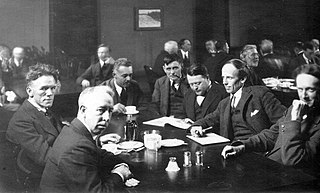
The Group of Seven, once known as the Algonquin School, was a group of Canadian landscape painters from 1920 to 1933, originally consisting of Franklin Carmichael (1890–1945), Lawren Harris (1885–1970), A. Y. Jackson (1882–1974), Frank Johnston (1888–1949), Arthur Lismer (1885–1969), J. E. H. MacDonald (1873–1932), and Frederick Varley (1881–1969). Later, A. J. Casson (1898–1992) was invited to join in 1926, Edwin Holgate (1892–1977) became a member in 1930, and LeMoine FitzGerald (1890–1956) joined in 1932.
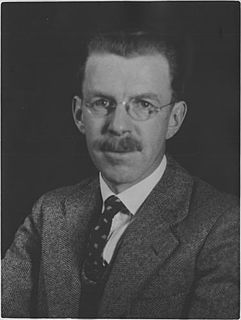
Franklin Carmichael was a Canadian artist and member of the Group of Seven. Though he was primarily famous for his use of watercolours, he also used oil paints, charcoal and other media to capture the Ontario landscapes. Besides his work as a painter, he worked as a designer and illustrator, creating promotional brochures, advertisements in newspapers and magazines, and designing books. Near the end of his life, Carmichael taught in the Graphic Design and Commercial Art Department at the Ontario College of Art.

Alfred Joseph Casson LL.D. (1898–1992) was a member of the Canadian group of artists known as the Group of Seven. He joined the group in 1926 at the invitation of Franklin Carmichael, replacing Frank Johnston. Casson is best known for his depictions in his signature limited palette of southern Ontario, and for being the youngest member of the Group of Seven.

Charles Fraser Comfort, LL.D. was a Scottish-born Canadian painter, sculptor, teacher, writer and administrator.
Jack Leonard Shadbolt, was a Canadian painter.
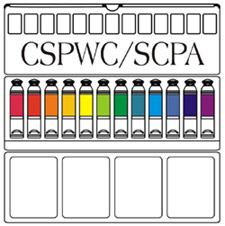
The Canadian Society of Painters in Water Colour, founded in 1925 is considered to be Canada's official national watercolour Society. Since the 1980s the Society has enjoyed Vice-regal Patronage from the incumbent Governor-General of Canada. Recognized by a long list of international exhibitions it is the Canadian equivalent of such other national societies as the American Watercolor Society of the United States, the Royal Watercolour Society of the United Kingdom, etc.
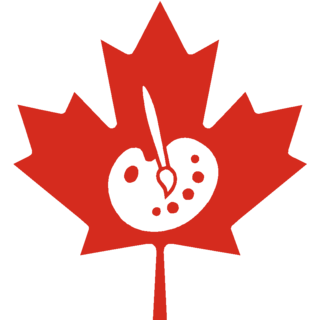
Painters Eleven was a group of abstract artists active in Canada between 1953 and 1960.
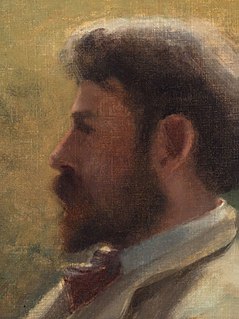
George Agnew Reid, also known as G. A. Reid, was a Canadian artist, painter, influential educator and administrator. He is best known as a genre painter, but his work encompassed the mural, and genre, figure, historical, portrait and landscape subjects.
James Williamson Galloway Macdonald, commonly known in his professional life as Jock Macdonald, was a member of Painters Eleven, whose goal was to promote abstract art in Canada. Macdonald was a trailblazer in Canadian art from the 1930s to 1960. He was the first painter to exhibit abstract art in Vancouver, and throughout his life he championed Canadian avant-garde artists at home and abroad. His career path reflected the times: despite his commitment to his artistic practice, he earned his living as a teacher, becoming a mentor to several generations of artists.

Helen Barbara Howard was a Canadian painter, wood-engraver, draughtsperson, bookbinder and designer who produced work consistently throughout her life, from her graduation in 1951 from the Ontario College of Art until her unexpected death in 2002.

Canadian art refers to the visual as well as plastic arts originating from the geographical area of contemporary Canada. Art in Canada is marked by thousands of years of habitation by Indigenous peoples followed by waves of immigration which included artists of European origins and subsequently by artists with heritage from countries all around the world. The nature of Canadian art reflects these diverse origins, as artists have taken their traditions and adapted these influences to reflect the reality of their lives in Canada.
Thomas Hodgson was a Canadian sprint canoer who competed in the 1950s, and also one of the acclaimed Canadian artists known as Painters Eleven. Competing in two Summer Olympics, he earned his best finish of eighth in the C-2 1000 m event at Helsinki in 1952.

Mary Augusta Hiester Reid was an American-born Canadian painter and teacher. She was best known as a painter of floral still lifes, some of them called "devastatingly expressive" by a contemporary author, and by 1890 she was thought to be the most important flower painter in Canada. She also painted domesticated landscapes, night scenes, and, less frequently, studio interiors and figure studies. Her work as a painter is related in a broad sense to Tonalism and Aestheticism or "art for art's sake".
Charles Goldhamer was an American-born Canadian artist. He is mostly known for his work as an official Canadian war artist during the 1940s.

Mary Evelyn Wrinch (1877–1969), was a Canadian artist who created miniature paintings, oil paintings, and block prints, sometimes inspired by the Northern Ontario landscape. She pioneered the 'Canadian style', painting landscapes with bold colours of the Algoma, Muskoka and Lake Superior regions, in situ. In her miniature paintings on ivory, she depicted her sitters with freshness and vitality. Her colour block prints are virtuoso examples of the medium.

Northern River is a 1914–15 oil painting by Canadian painter Tom Thomson. The work was inspired by a sketch completed over the same winter, possibly in Algonquin Park. The completed canvas is large, measuring 115.1 × 102.0 cm. Painted over the winter of 1914–15, it was completed in Thomson's shack behind the Studio Building in Toronto. The painting was produced as he was entering the peak of his short art career and is considered one of his most notable works. In 1915 it was purchased by the National Gallery of Canada in Ottawa and has remained in the collection ever since.

John Arthur Fraser, also known as John A. Fraser and J. A. Fraser was a British artist, photography entrepreneur and teacher. He undertook various paintings for the Canadian Pacific Railway. He is known for his highly realistic landscapes of Canada and the United States, many of them watercolor paintings.

Frederick Sproston Challener (1869–1959), also known as F.S. Challener, was a Canadian painter of murals as well as an easel painter of oils and watercolours and a draftsman in black-and-white and pastel. He also did illustrations for books and commercial art. He "easily ranks with the first few mural decorators in Canada", wrote Newton MacTavish, author of The Fine Arts in Canada
George Paginton was a British-born Canadian landscape painter.
Edward Scrope Shrapnel (1845–1920) was an English-born Canadian artist. After an earlier period spent in Quebec, his family settled in Orillia, Ontario. Having learned the basic art of drawing in the military, Shrapnel became adept in watercolour, his preferred medium. In the 1870s he began contributing works to the Ontario Society of Artists. He was elected an associate member of the Royal Canadian Academy in 1880. After a five-year stint as a drawing teacher for a women's college, he moved west to Victoria, British Columbia. Shrapnel was president of Victoria's first art association. His painting subject matter included landscape, still lifes, and genre, often incorporating scenes from Ontario and British Columbia.











